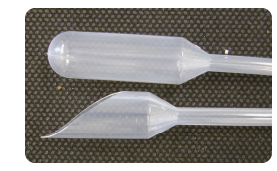Pour autoclaved 20% V8 broth into 100 X 15 mm Petri plates. It is best to NOT shake the broth before pouring it so that you do not transfer a lot of sediment with the broth. Try to decant clear liquid into the Petri plate so that it is easy to detect contamination later.
Inoculate the plates with a block of Pythium-colonized agar.
Place the plates on a tray and place the tray in a plastic bag. Seal the bag and place the tray in an incubator. OR, place the plates in a plastic box and close the lid.
If the cultures are contaminated with bacteria, the broth will become very cloudy overnight. Observing this is easiest if you put clear broth and not broth + solids in the Petri plate in the first place. If the plate is contaminated, it is likely because your original agar culture was contaminated. See module 2 for methods used for cleaning cultures.
After incubation, set up a Buchner funnel with vacuum.
Place coarse filter paper on the funnel.
With the vacuum on, pour the contents of the Petri plate onto the filter paper.
Rinse the mycelium with distilled water.
Turn off the vacuum.
Tear the mycelium into pieces that will fit into a 2 ml microcentrifuge tube. Do not totally fill or pack the tube tight if it is to be freeze-dried. Do not save the original inoculum block.
Put the tube in a freezer.
ALTERNATIVELY
Cut the agar inoculum block from the mycelial mat.
Pick up the mycelial mat from the Petri plate with forceps and, with the Petri plate held beneath the mycelium, hold it under running tap water until the media has been washed away.
Blot the mat on a clean paper towel or filter paper to remove as much moisture as practical.
Then tear the mat into segments that will fit into microcentrifuge tubes. Do not totally fill or pack the tube tight if it is to be freeze-dried.
Put the tube in a freezer.
Get as much mycelium as you can. Don't throw out any if it is possible to save it. Isolates may die later but you will still have a source of DNA if you save what you grow.
*In general, it is best to get the youngest mycelium ... not necessarily all of the mycelium. Some isolates yield relatively little DNA even if there is a lot of mycelium. (Moorman's theory = those isolates must 'abandon' older parts of the mycelium and have most of the active cytoplasm and nuclei near the tips.)
It is best to freeze-dry the mycelium in the microcentrifuge tube and then use a disposable pestle to grind the freeze-dried mycelium in that tube.

If you grind the mycelium in a porcelain mortar using a pestle, an easy way to get the powder out of the mortar and into microcentrifuge tubes for extraction is to create a disposable scoop. Cut the bulb of a disposable dropper at an angle and use that as a scoop. See the photo to the right. You can even pinch the 'scoop' so that it slides into a microcentrifuge tube.
As an alternative to growing mycelium and extracting the DNA, you can use Direct PCR. In that method, you grow the Pythium on an agar plate and scrape the surface of the colony with a sterile pipet tip. You then dip the 'DNA contaminated' tip into a microcentrifuge tube that contains some of the PCR master mix. See a more detailed description in the next section of this module (DNA sequencing).

